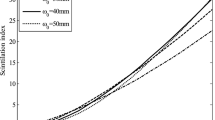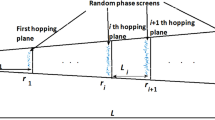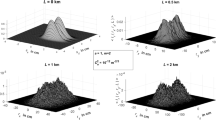Abstract
The analytical expression for scintillation index of radial Gaussian beam array with coherent combination based on Kolmogorov power-law spectrum in the horizontal path is derived. The influences of the beam number and ring radius on the scintillation index are studied. The results show that the scintillation index can be reduced by increasing beam number and an optimum ring radius is proved to exist. Further, the optimum ring radius greatly depends on the source size and exists only in a certain range of the source size determined by the propagating distance. Additionally, the scintillation index distributions at the receiver greatly depend on the source size.







Similar content being viewed by others
References
X. Li, X. Ji, H.T. Eyyuboglu, Y. Baykal, Appl. Phys. B 98, 557–565 (2010)
A. Peleg, J.V. Moloney, J. Opt. Soc. Am. A 23, 3114–3122 (2006)
P. Polynkin, Opt. Lett. 32, 885–887 (2007)
L.C. Andrews, R.L. Phillips, Proc. SPIE 4489, 23–34 (2002)
L.C. Andrews, R.L. Phillips, Laser Beam Propagation through Random Media (SPIE, Bellingham, Washington, 2005)
H.T. Eyyuboglu, Y. Baykal, Appl. Opt. 46, 1099–1106 (2007)
H.T. Eyyuboglu, Y. Baykal, J. Opt. Soc. Am. A 24, 156–162 (2007)
Y. Baykal, H.T. Eyyuboglu, Appl. Opt. 45, 3793–3797 (2006)
Y. Gu, G. Gbur, Opt. Lett. 35, 3456–3458 (2010)
H.T. Eyyuboglu, Y. Baykal, Y. Cai, Appl. Phys. B 91, 65–271 (2008)
H. Tang, B.L. Ou, B. Luo, H. Guo, A.H. Dang, J. Opt. Soc. Am. A 28, 1016–1021 (2011)
Y. Baykal, J. Opt. Soc. Am. A 23, 889–893 (2006)
I.S. Gradshteyn, I.M. Ryzhik, Tables of Integrals, Series and Products (Academic, Burlington, San Diego, 2000)
J.P. Campbell, L.G. Deshiazer, J. Opt. Soc. Am. A 59, 1427–1429 (1969)
Acknowledgments
This work is supported by National Natural Science Foundation of China (Grant No. 60837004, No. 61101005 and No. 61008049) and the project sponsored by the Scientific Research Foundation for the Returned Overseas Chinese Scholars, State Education Ministry.
Author information
Authors and Affiliations
Corresponding authors
Appendix: Derivation of Eq. (9)
Appendix: Derivation of Eq. (9)
The incident field on a source plane (z = 0) for the general beam is given by [12]
where l is the number of the set of multimode content, (n, m) are the specific mode within the l th set, A lnm is the amplitude of the field at the source plane, θ lnm is the constant phase factor, H n and H m are Hermite polynomials of order n and m determining the field distributions in the s x and s y directions, α xln and α yln are the complex parameters characterizing the width of Hermite polynomials in the s x and s y directions, b xln and b yln are complex parameters characterizing the displacement of Hermite polynomials in the s x and s y directions, V xln and V yln are the complex displacement parameters associated with the Gaussian part of the beam in the s x and s y directions, respectively.
If n = m = 0, A lnm = 1 and \(\alpha_{xl}=\alpha_{yl}=\alpha_l={1 / {(kw_0^2)}}, \) Eq. (10) can be reduced to Eq. (2) with \(V_{xl}={{\left( {i{R_0}\cos {\varphi _n}} \right)} / {w_0^2}}, V_{yl}={{\left( {i{R_0}\sin {\varphi _n}} \right)} / {w_0^2}}\) and \(\theta_l=- {{iR_0^2} / {\left( {2w_0^2} \right)}}. \) After using Huygens–Fresnel principle and Rytov method, the scintillation index Eq. (3) under weak fluctuation conditions on the receiving plane can be obtained. Upon substituting Eqs. (4), (5) and (8) into Eq. (3), σ 2I (p,L) is expressed as
Recalling the integral formula \(\int\nolimits_0^{2\pi } {{\mathop{\rm d}\nolimits} \theta \exp \left( {x\cos\theta + y\sin \theta } \right)} = 2\pi {I_0}\left[ {{{\left( {{x^2} + {y^2}} \right)}^{{1 / 2}}}} \right]\) to perform θ integration, and expanding Bessel function in the integrand in a Maclaurin series, then using the integral formula \(\int\nolimits_0^\infty {{\mathop{\rm d}\nolimits} t{t^{\nu - 1}}\exp \left( { - \mu {t^p}} \right)}= {p^{ - 1}}{\mu ^{ - {\nu / p}}}\Upgamma \left( {{\nu / p}} \right), \kappa\) integration can be performed. Finally, Eq. (9) can be obtained and simplified by using the confluent hypergeometric function of first kind \({}_1{{\mathop{\rm F}\nolimits} _1}\left( {a,c,z} \right) . \)
Rights and permissions
About this article
Cite this article
Tang, H., Wang, B., Luo, B. et al. Scintillation optimization of radial Gaussian beam array propagating through Kolmogorov turbulence. Appl. Phys. B 111, 149–154 (2013). https://doi.org/10.1007/s00340-012-5318-9
Received:
Accepted:
Published:
Issue Date:
DOI: https://doi.org/10.1007/s00340-012-5318-9




